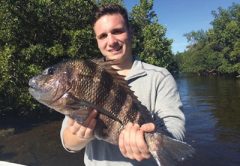My father loved to fly-fish for bluegill. Growing up in Ohio, he kept a small boat on Mogadore Reservoir and every opportunity he had he’d be fly-fishing for hungry panfish.
With much patience, he was able to teach my brothers and I the graceful art of landing a small fly or popper on top of a bluegill bed. We couldn’t have been more than 8-10 years old but he made the learning process fun.
Our training was “dry-casting” in the back yard, with my father guiding us on the smooth release of line and allowing the line to “straighten out” before casting forward. We often made a competition out of the training, placing a trash can lid in the grass for a target, and then betting on who could place the fly on top the can.
In those days fly lines had to be “dressed” in order to float, so prior to our trips, we’d get out the fly rods and tie the line to a tree branch some 25 or 30 feet away and use a small cloth to coat the lines with a waxy substance, and then wiping it off to leave a thin coat of wax. Just enough to allow the line to float. Nowadays, fly lines are available in weight-forward floating styles.
Since then, I’ve fly fished in freshwater around the country for panfish, bass, trout and salmon and my collection of fly rods has increased dramatically. After moving to Florida, I added saltwater fly rods for snook, reds, seatrout and tarpon.
Although I consider myself a bass fisherman and fly rods are not allowed to be used in bass tournaments, I still do quite a bit of fly-fishing in Florida.
For newcomers to the sport, or those of you interested in learning more about fly-fishing, here are a few of the basic things you need to know.
For starters, fly-fishing isn’t just a “gentlemen’s” form of fishing. Nor is it a style of fishing designed primarily for trout and salmon. Although there are many fly fishermen who consider themselves to be true “purists” of the sport, fly-fishing can be applied to almost any type of fish that swims.
Unlike spinning and casting rods, fly rods are typically rated by a number. The smaller the number, the lighter the rod. The higher the number, the more powerful the rod. So for example, a 3 wt fly rod might be perfect for small trout, while a 12 wt would be much better suited for tarpon.
Fly rods are matched with reels and line of the same number or weight. Buying a 5 wt fly rod would require a matching 5 wt reel and 5 wt line. Although there are exceptions to this rule, you will get the best results matching the rod, reel and line.
Originally, fly rods were made of bamboo, then fiberglass and today most are graphite. Graphite rods provide the lightest and greatest sensitivity for virtually all types of fly-fishing.
My favorite two rods for fishing for bluegill are a 7 ½’ 3 wt and a 9’ 5 wt. Both are exceptionally good outfits and both allow me to cast small, size 10 and size 12 flies and poppers.
For bass, I have a 6 wt, 9’ and an 8 wt, 9’ rod. Both are great for bass fishing. I generally fish with size 6-8 poppers with the 6 wt and larger bass popping bugs and streamers with the 8 wt.
Fly rods can range in price from $69.00 to $750.00 and reels pretty much fall into the same price range. But for a decent rod expect to pay around $100.00. A matching reel can be found for $50.00 – $75.00. Line will run another $35.00 to $50.00.
The best and longest casts will be with a 9’ rod. Shorter rods, like my 7 ½’ 3wt are great rods for fishing small creeks or areas with trees and over-hanging brush.
Fly-fishing is also very effective in saltwater. I fish with an 8 wt fly rod for snook, reds and seatrout. These fish will strike almost any streamer, fly or popper and catching a 3-8 pound saltwater fish is incredible with a fly rod.
I fish for tarpon with a 12 wt and although I’ve never actually landed one. I’ve hooked many that gave me the most incredible fight before eventually breaking my leader. For many fishermen, catching a 5-6’ tarpon is the greatest of all fishing challenges.
The best time for bluegill fishing is in the spring when the fish are on their beds. Using a small popper, you can expect a “strike” on almost every cast. Live bait is seldom used since it is easily lost while casting the tiny bug.
But as fall approaches and the water cools, both panfish and bass will move shallower and become prime targets with small flies and poppers, particularly early morning and late afternoon into evening.
If you’ve never tried fly-fishing, give it a try. It’s not hard to learn how to cast and playing a fish of any size is an experience you’ll long remember.
[easy-social-share]






